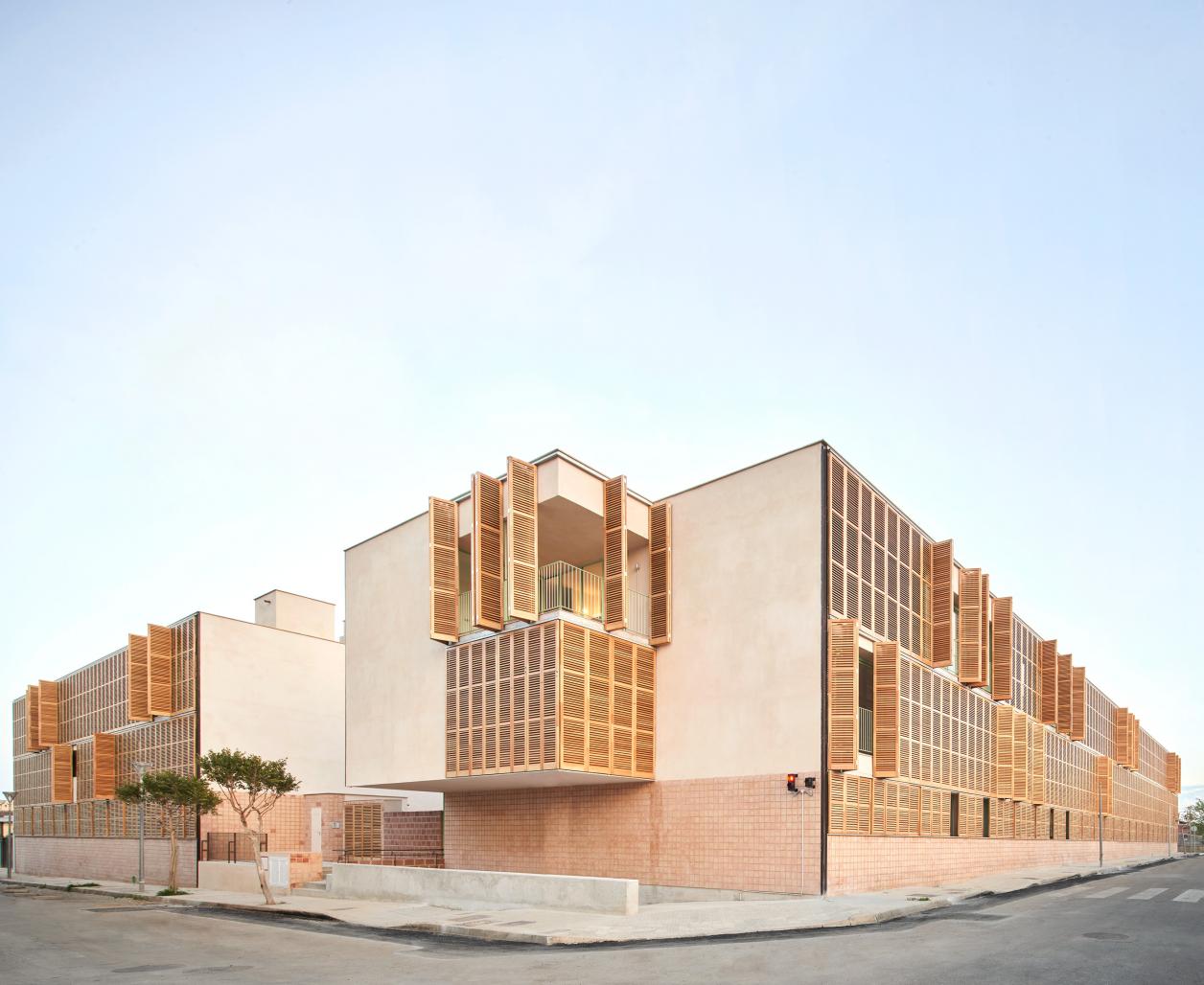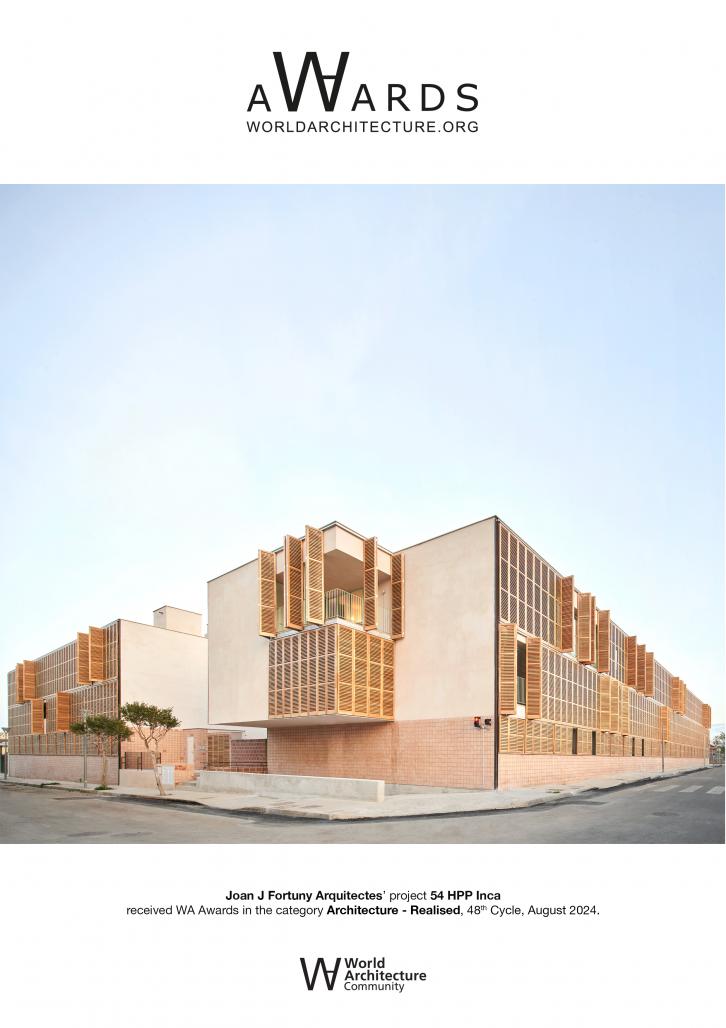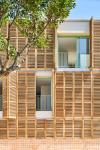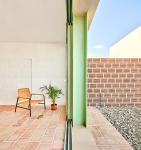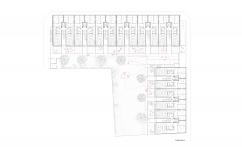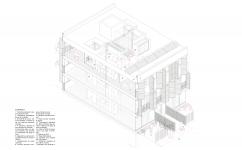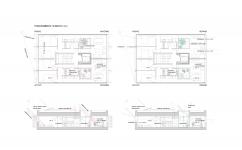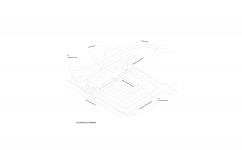This project is located in Inca, at the heart of Mallorca (Balearic Islands, Spain). Consists of 54 social protection homes and parking on an Administration-owned rectangular-shaped plot of 3,266 m2 area.
The proposal resolves two fundamental aspects: the correct insertion of the building into the urban and physical environment and a solution that is a synthesis of the functional aspects of the program.
The building is organized along a north-south axis that gives rise to the location of two independent volumes, generating a public space between them. The housing modules are organised around a central wet core that defines day and night areas, according to the site characteristics and its uses. Its structure is a reticular system of concrete slabs with large spans 35 cm thick and metal pillars that save construction time and give flexibility of reconversion on future needs. The homes have cross ventilation and outdoor spaces: a private garden on the ground floor, terraces and patios on the successive floors, which will allow the excess of summer heat to be regulated through passive strategies. The finishing and materials are strictly related to circularity, prioritising the vernacular ones and working with local industry or craftsmen.
The line of action has been implementing a series of passive strategies that reduce the energy demand for heating and cooling. Consequently, all homes have cross ventilation, solar protection, great thermal inertia in floors and walls and hygroscopically regulating humidity and perspiring materials. It is strategically designed to have the maximum solar collection in winter and accumulate energy in the inertia of the construction itself.
2022
2023
The housing module is organised around a central wet core that defines two areas with double orientation. The location of day and night areas varies in height, generating different housing types per floor. The homes have patios, terraces and private gardens that allow greater air intake in winter and improved ventilation. The vegetation will regulate sunlight, temperature and humidity.
The façade is resolved by a double ceramic sheet with exterior insulation using projected cork and lime coarse developed by local companies, and solar protection made of larch wood (FSC) manufactured by local artisans.
The coverings are ceramics fired with biomass, and the lime paint is applied directly on the ceramic walls to give hygroscopic capacity and inertia to the homes.
The finishing and materials are strictly related to circularity in an exceptional spot like the singularity of this Mediterranean Island, developed by local industry or craftsmen as much as possible. When it couldn’t be possible (wood /recycled aluminium), the chosen material is because of its very low carbon footprint.
Pavements are local clay “cocked” with biomass. We have reduced the areal facilities to the bathroom areas so in this wet area it’s the only ceiling, reducing layers on the whole construction on the circularity concept, in the same concept all the electric services, plumbing and pipes run over the walls to have an easy maintenance.
The Roofs are solved by recycled gravel from urban mining. The photovoltaic panels will provide the electricity needs of the building. The ACS is produced by a NUOS aerothermal system with low consumption and high performance. The ventilation of the homes is resolved through heat recovery that tempers the air thanks to community aerothermal systems.
This process results in a building with practically zero consumption (0.64 kWh/m2 x year ‘NZBE’) developed from a local economy model, passive strategies and naturally healthy materials.
The building is organized along a north-south axis that gives rise to the location of two independent volumes, generating a public space between them.
The community spaces on the ground floor have solved the circulations with a concrete floor and the entirety of the space by pavements that allow the natural permeability of the ground, allowing natural flow to the subsoil. Local trees will protect the circulations from the summer sun.
- Architects in charge: Joan Josep Fortuny Giró, Xavier Morell, Marc Alventosa (F-AM Arquitectes)
- Collaborators: Oscar Canalis, Laura Jaume (architects); Estudis d’Enginyeria de les Illes (engineering); Marco Menéndez, Jaime Oliver (technical architects); Maria Morell, Gori Llambias, Sandra Vargas (architects); Juan Fortuny, Joan Mas, Lluís Guasp (structural engineering).
54 HPP Inca by Joan Fortuny in Spain won the WA Award Cycle 48. Please find below the WA Award poster for this project.

Downloaded 0 times.
